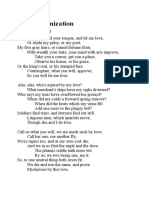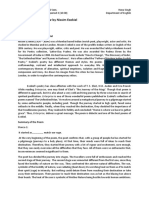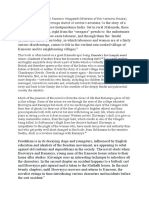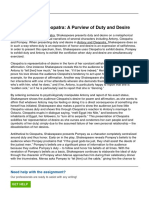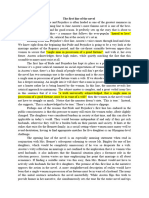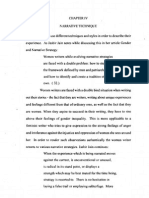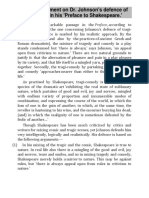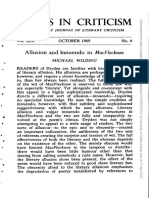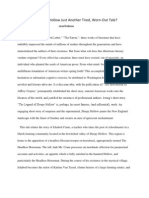THE CANONIZATION BY JOHN DONNE |
CRITICAL ANALYSIS|EVERYTHING IN ONE
PDFINTRODUCTION TO THE POEM
The Canonization" is a poem by English
metaphysical poet John Donne. Firstpublished in
1633, the poem is viewed as exemplifying Donne's
wit and irony.[1] It isaddressed to one friend from
another, but concerns itself with the complexities
ofromantic love: the speaker presents love as so all-
consuming that lovers forgo otherpursuits to spend
time together. In this sense, love is asceticism, a
major conceit inthe poem. The poem's title serves a
dual purpose: while the speaker argues that hislove
will canonise him into a kind of sainthood, the poem
itself functions as acanonisation of the pair of lovers.
WHAT DOES CANONIZATION MEAN
1.The Paradox: the title of the poem 'Canonization"
itself is a paradox. That is theunderling metaphor of
the poem. Donne treats the theme of love in his
poem, butthe title suggests a saintly thing.2. (in the
Roman Catholic Church) the o cial admission of a
dead person intosainthood.3. This title suggests that
the poet and his beloved will become 'saints of love'
in thefuture, and they will be regarded as saints of
true love in the whole world in thefuture.One of the
most important elements of The Canonization' is the
use of an extendedmetaphor. known as conceit. This
type of metaphor is often unusual and challenging.In
the final stanzas, the speaker introduces a metaphor
comparing himself and hislover to a phoenix. In this
form, they are able to live, die in a blaze of passion,
andthen live again even more beautifully. This is a
double reference in that "death" canrefer to a climax
in a sexual relationship.
STANZA WISE ANALYSIS OF JOHN DONNE'S
POEM "THE CANONIZATION"
The poem "The Canonization" written by John Donne
is about love. Throughout thispoem Donne reveals
both concepts of physical love and spiritual love. The
wordsthat Donne has chosen in this poem are an
example of a poetic technique that notonly allows
the reader to understand the speaker, but also be
able to see imagesbased on his word choice about
the di erent aspects of love.The forty-five lines of
John Donne’s “The Canonization” are divided into
fivenine-line stanzas, a form that suggests a five-act
play. The title reflects the
speaker’s conviction that in opposing the claims of
the world (business, courtlyambitions), he and his
beloved have become love’s martyrs, and therefore
saints.In the first stanza the opening line is "For
God's sake, hold your tongue, and let melove!" This
line shows the importance of love to the speaker in
this poem when hedemands to let him love. The
speaker also refers to the physical aspects of
himself,he gives the reader an image of an older
person. The first three lines show that truelove is
powerful, that it is not based on physical attributes,
and that love is timeless.Unlike artificial love.The
first-person speaker appears to be addressing an
outsider who isunsympathetic to his romantic
involvement and who has said as much prior to
thefirst line. The poem, then, is a type of dramatic
monologue, in which the speakerdefends and later
celebrates his love against the outsider’s objection.
In the firststanza, he commands the outsider to hold
his tongue and tells him to scold himabout being too
old for love if he wishes, but not about being in love.
He suggeststhat the outsider pursue his own
ambitions or do whatever he likes, so long as
heleaves him alone to love.In the second stanza, the
speaker adopts a defensive tone, arguing that no
one is“injured” by his love, as the outsider may have
charged. Donne employs severalconventional
Petrarchan metaphors (poetic clichés by that time),
insisting that hislover’s sighs have not sunk any
merchant ships, nor has his heated passion
causedan early spring to be delayed. He concludes
that argumentative soldiers and lawyerscan still
bicker even though he finds contentment in love.The
third stanza represents the uncertainty that people
face while they are falling inlove. He speaks of his
possible sadness and risk of heartache by falling in
love. Thespeaker reacts to apparent name-calling on
the part of the outsider, insisting thathe and his
beloved are “flies” (in the diction of his age, moths
or butterflies) or“tapers” (candles), which gain
fullness of life even as they consume
themselves.(Renaissance English poets commonly
employed the word “die” as a sexual pun,based on
the folk belief that each orgasm shortened one’s life
by a day.) Likeningthe physically and spiritually
united lovers to the phoenix, a mythical bird that
wasthought to erupt into flame and then be
resurrected from its own ashes, the speakerclaims
that they are proven “mysterious” (in the spiritual
sense) by this ideal love.This constitutes the climax
or turning point of this small drama. At the end of
thisstanza the speaker answers all of his own
questions with the statement "Though sheand I do
love." in line eighteen. Meaning that regardless of
the bad things in life thatcould happen the speaker
and his lover will love one another.In the fourth
stanza the speaker explains that if they do literally
die from their love,it will be a martyrdom, and their
saints’ legend will be an appropriate subject
forpoetry (as this poem itself proves), so they will
also live because of their love. He
expands his point metaphorically by suggesting that
if their love is not suitable forchronicles, it will do for
sonnets, and that a carefully made funeral urn is as
suitablefor famous personages as “half-acre tombs”
like the pyramids.Throughout the fifth stanza Donne
describes the spiritual aspect of love through
thespeaker, while at the same time through certain
words the speaker is saying Donneis showing the
reader the physical love between the speaker and
his lover. By doingthis Donne shows that spiritual
and physical love may be di erent, but they are
alsoconnected. An example of these two aspects of
love being shown at the same time isin line twenty
and twenty-one "Call her one, me another fly; We
are tapers too, andat our own cost die;" These lines
Donne uses the metaphor of a moth drawn to
aflame. This being a metaphor of spiritual love is
about how the speaker is destinedto be with his
lover and how he is drawn to her. On the other hand,
in line twenty-oneit says, "We are tapers too, and at
our own cost die;" This line is a metaphor of acandle,
which is a symbol of love and a source of heat. This
metaphor shows thereader the physical passion
between these two lovers and the way Donne uses
theword "die" in line twenty-one is referring to an
orgasm between these two lovers.Within this one
line he shows that the speaker and his lover are both
physically andspiritually connected.In addition,
stanza five and six they both enforce the idea of
living and dying forlove when lines twenty - one,
twenty - six, and twenty - eight that state "at our
owncost die ... We die and rise the same ... We
can die by it, if not live by love," Thesemeans that
the two lovers will always be connected, although in
time they will die aphysical death they will live on to
be "A pattern of ... love!" in line forty - five.Meaning
that because of their love they will live on
throughout time being "apattern" for future
generations of lovers.Finally, Donne is a very skillful
poet by using one word to have multiple
meanings.This poem is full of imagery that allows
the reader to fully understand the twoconcepts of
love while explaining one through words and
showing the other by usingthose same words. This
concept of spiritual and physical love being
di erent, but atthe same time connected to one
another is very interesting. "The Canonization" isnot
only about the relationship between the speaker and
his lover, but between allmen and women who are
in love, falling in love, and waiting to love and be
loved inreturn.
JOHN DONNE CANONIZATION AS A
METAPHYSICAL POEM
“The Canonization” is filled with metaphysical
elements. Donne employsmetaphysical conceits,
such as comparing the lovers’ love to a
religiouscanonization, to explore the depth and
intensity of their connection. The poem alsodelves
into metaphysical themes like the interplay between
the physical andspiritual realms, the transcendence
of earthly constraints, and the power of love to
elevate and transform. These metaphysical
elements add layers of complexity andintellectual
depth to the poem, making it a fascinating
exploration of love andspirituality.The poem
captures the aphoristic style of writing. “The
Canonization” by JohnDonne contains several
aphoristic statements. These concise and
memorableexpressions of wisdom encapsulate
profound truths about love, spirituality, and
thehuman experience. For example, Donne writes,
“Love’s not love / Which alters whenit alteration
finds.” This aphorism suggests that true love
remains steadfast andunchanging, even in the face
of challenges and changes. Another
aphoristicstatement in the poem is “For God’s sake
hold your tongue, and let me love.” Thisline
encapsulates the speaker’s plea for others to refrain
from criticising orinterfering with their love. These
aphorisms contribute to the richness and depth
ofthe poem, o ering timeless insights into the
nature of love and relationships.The poem
encapsulates the platonic love where Donne
portrays a love thattranscends the physical and
materialistic aspects typically associated with
romanticlove. Instead, he emphasises the spiritual
and intellectual connection between thelovers. The
poem suggests that their love is elevated to a higher
plane, akin to thelove shared by saints and religious
figures. This platonic love is characterised by adeep
understanding, mutual respect, and a shared pursuit
of spiritualenlightenment. It goes beyond physical
desires and embraces a more profound
andtranscendent connection.In “The Canonization,”
Donne employs metaphysical conceits to explore the
depthof the lovers’ connection. For instance, he
compares their love to a “canonization,”suggesting
that their love is worthy of being declared sacred
and revered like thecanonization of saints. Another
example is when Donne compares their love
to“alchemy,” implying that their love has the power
to transform and transmuteordinary experiences
into something extraordinary. These metaphysical
conceitsadd layers of complexity and depth to the
poem, making it a fascinating explorationof love and
spirituality.
TRACE OUT THE METAPHYSICAL TRAITS IN
THE POEM CANONIZATION
"Canonization" by John Donne is a metaphysical
poem that explores complexthemes through
intellectual and abstract reasoning. The
metaphysical traits in thepoem include intricate
conceits, paradoxes, and a blending of the spiritual
and theearthly.
The poem opens with a speaker challenging those
who criticize his love, turning their judgments into
a sarcastic celebration of his relationship. The
metaphysical conceitof comparing love to
canonization implies a divine elevation of their
union.Donne employs paradoxical language, such as
"Dull sublunary lovers' love," toconvey the idea that
earthly love is inferior to their transcendent
connection. The juxtaposition of opposing
concepts is a hallmark of metaphysical
poetry,emphasizing the depth and complexity of the
speaker's emotions.The poem also delves into the
tension between worldly concerns and
spiritualaspirations. The lovers are portrayed as
sacrificial victims, facing persecution fortheir
devotion, yet achieving a kind of martyrdom that
elevates their love to ahigher plane.In summary,
"Canonization" showcases metaphysical traits
through its intricateconceits, paradoxical language,
and the blending of spiritual and earthly elements,all
contributing to a nuanced exploration of love and its
societal perceptions.
USE OF PARADOX:
Donne treats physical love as if it were divine love.
Saints are canonised for theirrenunciation of the
world and its comforts. In the same way, the lovers
haverenounced the material world. The love of
Donne for his beloved causes no damageor injury to
the society or to the world: Other people continue to
carry on theirnormal daily chores and duties. The
lovers have lost the world but gained more inthe
world of each other. The lovers are, so to say, dead
to the world. They have,therefore, deserved the
status of saints. They are the saints whose blessings
otherlovers will invoke. The lovers are devoted to
each other as a saint is devoted to God.Some people
may regard it as a paradox of Christian
Canonization, but there is nodoubt that the tone of
the poem is both serious and convincing.
CANONISATION AS A MARTYR SAINTS
:Lovers will worship the poet and his beloved as the
martyrs to love. Lovers willinvoke the blessings of
these martyr saints. Love will bring them both peace
andsolace. Like them other lovers will devote
themselves entirely to their respectivebeloveds.
Each will find in his beloved the whole soul of the
world: The lovers willpray to God to grant them the
same kind of true love which the poet and
thebeloved enjoyed while living in the world.How
does "The Canonization" portray its messages about
love and poetry?Quick answer:In the poem "The
Canonization" by John Donne, the poet enacts his
messagesconcerning love and poetry by equating
love to a state of holiness. The poetexpresses a
desire to be free to love, an observation that his love
harms no one else,
and a declaration that his love is empowering. He
and his lover will be rememberedin love poems
instead of on tombs. Others will derive inspiration
from their love andpray to them as saints.
FORMS AND DEVICES
This poem is a triumph in the “complex stanza”
form, which derives from theclassical ode and which
requires that the poet contrive a fresh rhyme
scheme(abbaccca in the present case) and use a
variable line length as well. Donne employsa free
iambic foot and a metre that varies from pentameter
(ten syllables per line) inthe first, third, fourth, and
seventh lines to trimeter (six syllables) in the last
line ofeach stanza. The remaining lines are in
tetrameter (eight syllables). Donne frameseach
stanza by closing o the first and ninth lines with
the word “love,” whichaccordingly echoes
throughout the poem.
CRITICAL ANALYSIS OF THE POEM
The CanonizationThe Canonization is a metaphysical
poem written by the renownedpoet John Donne. In
this profound piece of literature, Donne explores the
themes oflove, spirituality,and the power of poetic
creation. The poem begins with the
speakerdefending his love against critics who belittle
it as mere infatuation. He argues thathis love is
elevated and transcendent, akin to the divine.
Donne employs the conceptof canonization, usually
associated with the process of recognizing saints,
toemphasise the sanctity and significance of his
love.The speaker exalts hisrelationship, claiming
that their love is a holy union that defies
conventional societalnorms. He asserts that their
love story will become immortalised in the annals
ofliterature and their names will be celebrated like
the saints'. The paradoxical natureof their love is
highlighted, as it is both profane and sacred,
forbidden andelevated.Through the use of vivid
imagery, Donne creates a world in which their loveis
an ethereal force that permeates every aspect of
their lives. The poem intertwinesreligious imagery
with the speaker's devotion to his beloved, blurring
the linesbetween earthly and divine love.Donne's
mastery lies in his ability to blend wit,intellect, and
emotion, making The Canonization a thought-
provoking and enduringpiece of poetry. It challenges
societal conventions and raises questions about
thenature of love, the power of art, and the
intersection of the earthly and the spiritual
THEMES AND MEANINGS
“The Canonization” argues for the superiority of
love’s unifying and reconcilingpotential over the
divisive and antagonistic impulses of the ordinary
world. Inpursuing personal ambitions in business or
at court, people like the imaginedoutsider and
courtiers, soldiers, and lawyers trade serenity for
strife. The speakerargues that an ideal love, which
is both physical and spiritual, can provide aparadigm
for the confused world, and he asserts that this
poem proves his point.
The reference to the king in the first stanza causes
some scholars to associate thepoem with the
accession of James I in 1604. Only three years
earlier, Donne had puta disastrous halt to his own
courtly ambitions when he eloped with Ann More,
theward of his employer, Sir Thomas Egerton, Lord
Keeper of the Seal. Ann More’sfather had Donne
blackballed, in e ect, and the couple experienced
severe financialstrain for several years. This poem
might be seen, then, as an explanation or even
a justification of his apparently
impulsive behaviour.If his intended audience for the
poem was King James himself, Donne’s appeal
musthave fallen on deaf ears, since another ten
years were to pass before his fortunesimproved. The
marriage was apparently a happy one, however, and
Ann Donne wasto bear nine children before her
death in 1617. John Donne did not remarry.
THEMES
"The Canonization" by John Donne explores several
interconnected themes:
Love as Sacred:
The poem delves into the idea of love elevated to a
sacred status.Donne argues that the love between
him and his beloved is so pure and powerfulthat it
deserves to be canonised like saints.
Spiritual and Physical Union:
Donne weaves together the physical and
spiritualaspects of love, suggesting that the union
between two lovers is not only a physicalact but also
a transcendent, spiritual experience.
Opposition to Criticism:
The speaker addresses potential critics who might
questionor criticise their love. Donne defends the
legitimacy and significance of theirrelationship,
dismissing societal norms and asserting the timeless
nature of theirlove.
Timelessness and Immortality of Love:
The poem emphasises the eternal natureof true
love, suggesting that it transcends the constraints of
time. The love betweenthe speaker and his beloved
is portrayed as enduring and immortal, defying
thelimitations of mortality.
Personal Identity and Sacrifice:
Donne explores the idea that love involves
amerging of identities. The lovers sacrifice their
individual selves for the sake of therelationship,
creating a harmonious and integrated
existence.Overall, "The Canonization" combines
metaphysical wit, passionate emotion, andintricate
wordplay to explore the complexities of love in both
a physical and spiritualsense.
CONCLUSION OF THE CANONIZATION
To conclude, the poem is a well wrought piece of
great poetry. The Blend of feelingand thought,
passion and ratiocination is flawless. Donne's wit
controls not only theflow of his emotion but also the
imagery and the structure of the poem.
Theverification is complex. But it is so powerful that
it describes Donne's special insightmost e ectively.
There is no obscurity anywhere and there is no
looseness. Or crack,in the structural unity of the
poetic thought, either. Even the cardinal images
areskillfully related to one another. The phoenix, for
example, is a bird. But like thetapers it also burns.
Evidently the poem is a massy diamond of great
poeticbrilliance. It has a sweep which is as powerful
as a sea wave.



